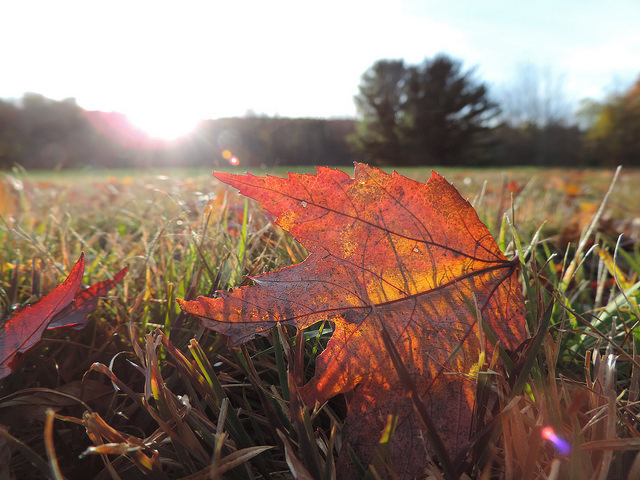By Emma Roth, Nature Educator
We are bombarded with external stimuli every second of the day. Our senses constantly work to tell us what’s around, what to avoid, and what to seek out. I’m not a neuroscientist, but I imagine the number of sensory inputs we receive at any given time is huge.
One of the classroom programs Audubon educators teach is Animal Senses, a program about how different animals use their senses to find food and to stay safe. As I write this, I am sitting in an elementary school faculty room, having just taught this class, and senses are on my mind. I am also looking out the window at the bright red leaves of a maple tree that has given me a thought experiment. Can I narrow down each of the five senses to one single input that epitomizes fall for me. The one thing I hear, see, smell, taste, and feel that instantly lets me know fall is here.
How do you tell it’s fall? There are hundreds of signs to look for, and it’s hard to miss. Leaves turn all sorts of bright colors. Plants start to wither and die. Birds stop singing their summer songs and some leave for warmer climates. Chipmunks search frantically for acorns and nuts to store for the coming winter. I decided to try to distill my senses and find the five signs that most clearly represent fall to me.
Sight. I thought this one would be easiest, but now I’m not sure. Of course, I immediately think of the brightly colored leaves. But that is too broad. I need to narrow it down to a single scene. A flurry of bright yellow leaves falling in a gust of wind. They are swirling all around, almost like snowflakes. They fall and add to the yellow leaf carpet on the forest floor.
Smell. Fall smells of damp soil full of freshly decaying leaves and plants. There’s something so earthy and primal about that musty smell. It’s the only time that the smell of death makes me happy. I think that’s because it’s not just a smell of death, it’s a smell of change and anticipation. A bittersweet smell as summer truly fades away and winter creeps towards the horizon.
Sound. Fall sounds like a large flock of geese that fly overhead, honking as they go. The sound gradually gets louder and louder as they fly closer. What starts as a faint commotion turns into a cacophony of honks as they are right above me. Then, as quickly as the sound grew, it fades away as the geese continue their journey south.
Touch. Fall feels like cold breeze on my nose, just cold enough that it’s almost uncomfortable, almost scarf weather, but not quite. This cool breeze is different from the summer winds that give a cool relief from the heat, or the winter gusts that seem to be trying to take your treasured heat away. This fall breeze is more delicate. It’s a neutral wind that doesn’t give or take, it’s just there.
Taste. This one is difficult. The other four senses are distinctly nature based. They are what I experience when I am out for a hike. I’d like to say there is some delicious wild edible encapsulates fall for me, but there’s not. I would be lying if I said my most fall-inspiring taste was anything but pumpkin roll. That delicious blend of pumpkin, spices, and cream cheese is one of the absolute highlights of fall to me.
So those are my five sensory highlights of fall. But as I write this, I realize I’ve never experienced all five of these sensations all at once. I’ve never been outside, eating pumpkin roll as a light wind tickles my nose, yellow leaves swirl around me, damp earthy smell rising from the ground, and geese flying overhead. I’ve created my ideal fall scene, now I just need to experience it.
Audubon Community Nature Center builds and nurtures connections between people and nature. ACNC is located just east of Route 62 between Warren and Jamestown. The trails are open from dawn to dusk and birds of prey can be viewed anytime the trails are open. The Nature Center is open from 10 a.m. until 4:30 p.m. daily except Sunday when it opens at 1 p.m. More information can be found online at auduboncnc.org or by calling (716) 569-2345.



Recent Comments